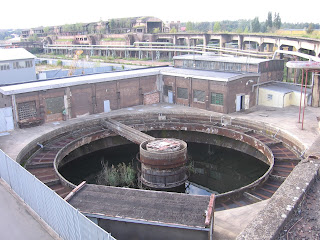Školská 28: Komunikační prostor
20. září – 5. říjen 2011
Prezentace projektu Heroes: 19. září 2011 - 17:00 hodin
Vernisáž výstavy: 19. září 2011 - 18:00 hodin
Umělci: Martin Janíček / Martin Zet / Danilo Capasso / Christian Costa / Jaro Dufek / Dominika Skutnik /Krzysztof Topolski aka Arszyn /
Kurátorky: Aleksandra Grzonkowska /PL/ Susanna Horvatovičová /IT/CZ/ Dagmar Šubrtová /CZ/
Spolupráce: MEMENEST Associazione Culturale, Naples
Communication space Školská 28, Prague
6. bienále Industriální stopy 2011 (Praha-Kladno)
Ideou projektu Není čas na hrdinství je představit skupinu umělců, kteří pracují a vyjadřují se intervencí v konkrétním veřejném prostoru. Není čas na hrdinství spojuje evropská města: Kladno-Prague, Neapol, Gdańsk. Přetrvávající problém privatizace nábřeží a globální spotřeby vody stimuluje analýzu využití říčních toků v rámci přepravy a komunikace. Dříve byla industriální zóna důležitou součástí výroby, nyní jsou tyto lokality někdy nebezpečné a zapomenuté, jinde si tato místa bere zpět příroda. Cílem je provádět výzkum zaměřený na konfrontaci a prezentace těchto průmyslových oblastí, vodních cest a moří, dále hledání strategií jak pečovat o tyto zóny, lépe je využít, a tím je zachránit.
Bývalý areál Vojtěšské huti Kladno Koněv – pozdější Poldi Kladno SONP je jeden z nejzajímavějších průmyslových komplexů v České republice. Tato historická průmyslová soustava objektů spočívala na velkých cementových nádržích, které uchovávaly vodu a další látky používané při výrobě oceli. Za zmínku stojí architektonická rozmanitost města Kladna zdůrazněna secesními vilami postavenými kolem továren od významných architektů jako byl např. Josef Hoffmann.
Český umělec Martin Janíček prezentuje zvukovou performanci a instalaci s reprodukovanými zvuky z industriálních zón v Kladně a v Gdaňsku. Martin Zet recykluje městské objekty a transformuje jejích funkci a smysl do jeho osobní vize naši současné společnosti.
Podle známé italské čtvrti "Spacca Napoli" je město rozděleno na dvě části. Východ Neapole je chudou čtvrtí okolo přístavu, kde byly v 80. letech postaveny obrovské továrny, které byly po deseti letech opuštěny. Západní oblast Neapole je zcela jiná. Jsou tam postavené luxusní vily s výhledem na moře nedaleko slavného parku Virgilio poblíž ostrova Capri.
Italští umělci Christian Costa a Danilo Capasso se zabývají úvahami o urbanistické historii východní Neapole a volí umělecké strategie intervence do periferních oblastí a jejich degradace. Fotografická a video instalace Danila Capassa zkoumá “hraniční prostory” východní Neapole a odráží “stav mezi existencí v minulosti a budoucími identitami”. Dokumentární video a cyklus fotografií Christiana Costy představuje kritický pohled na degradaci neapolských industriálných zón Cirio, Vela, Ponticelli, a na oblast přístavu.
Gdaňské loděnice jsou velmi unikátní. Zde začaly stávky, systémové změny a hnutí Solidarita. Město je zajímavé z pohledu využití nábřeží, které je příkladem přizpůsobení architektury díky změně její funkce (z průmyslových výrobních hal na umělecké lofty.
Přes metaforu hypnotického pohledu na let mořského racka polská umělkyně Dominika Skutnik rozlišuje originálním způsobem vztahy mezi světem snů, městských zvuků a hrou asociací. Jaro Dufek kombinuje různé druhy vody z Prahy, Gdaňska a Neapole v interaktivním projektu výuživající mobilních telefonů. Krzysztof Topolski aka Arszyn zkoumá různé strategie jak zachytit městské zvuky ve finální minimální hudební instalací.
Projekt No Time For Heroes je součástí programu 6. bienále Industriální stopy 2011 (Praha-Kladno) pořádaného Výzkumným centrem průmyslového dědictví při ČVUT v Praze (www.industrialnistopy.cz).
Podpora:
Rezidence Krzysztofa Topolského je podporován Visegrádským mezinárodním fondem, Visegrádský umělecký rezidenční program - VARP.
Polská část je podporována Institutem Adama Mickiewicze.
Spolupráce:
VÝZKUMNÉ CENTRUM PRŮMYSLOVÉHO DĚDICTVÍ FA ČVUT V PRAZE
Projekt Školská 28: Komunikační prostor je podporován Magistratem města Prahy. Výstavy a paralelní programy probihají od roku 2005 díky vřelé finanční podpoře Ministerstva kultury České Republiky.
Mediální partneři: Artmap, His Voice.
Školská 28: Komunikační prostor
v ul. Školské 28, P-1 ve dvoře - vstup průchodem, Praha
tel. +420 296 325 066, skolska28@skolska28.cz

























